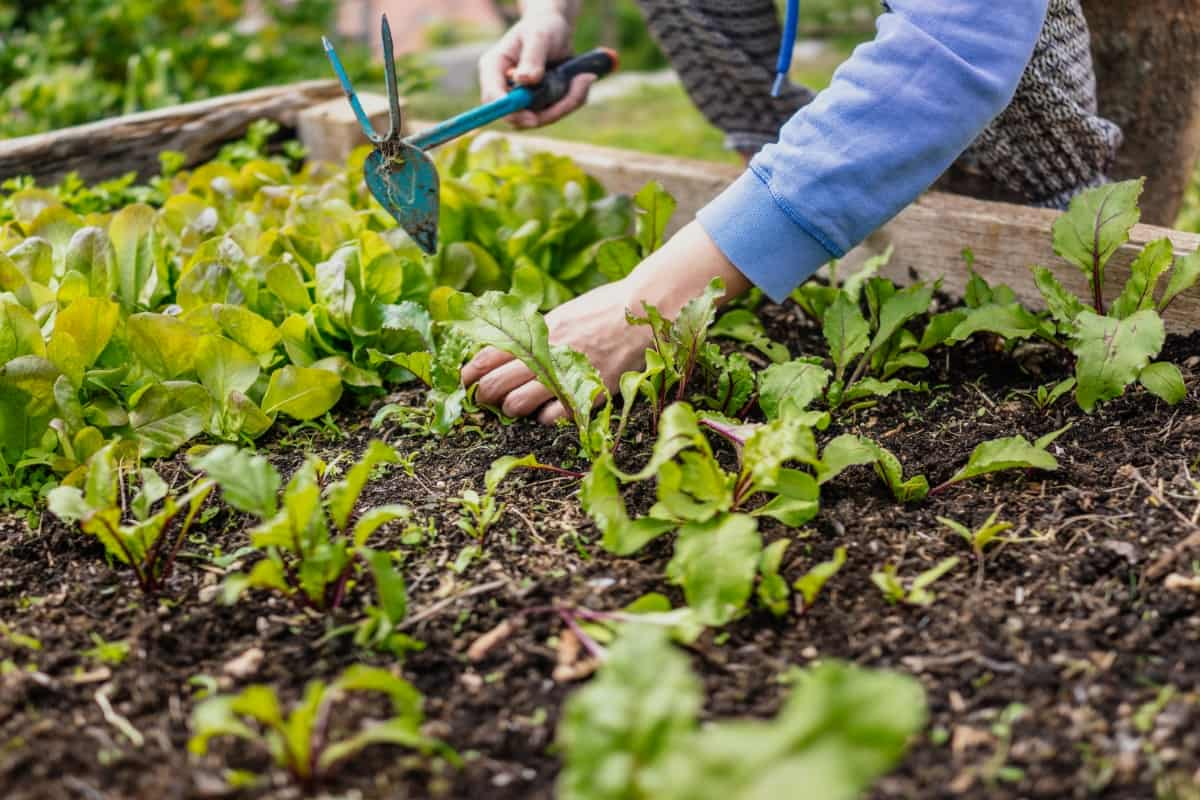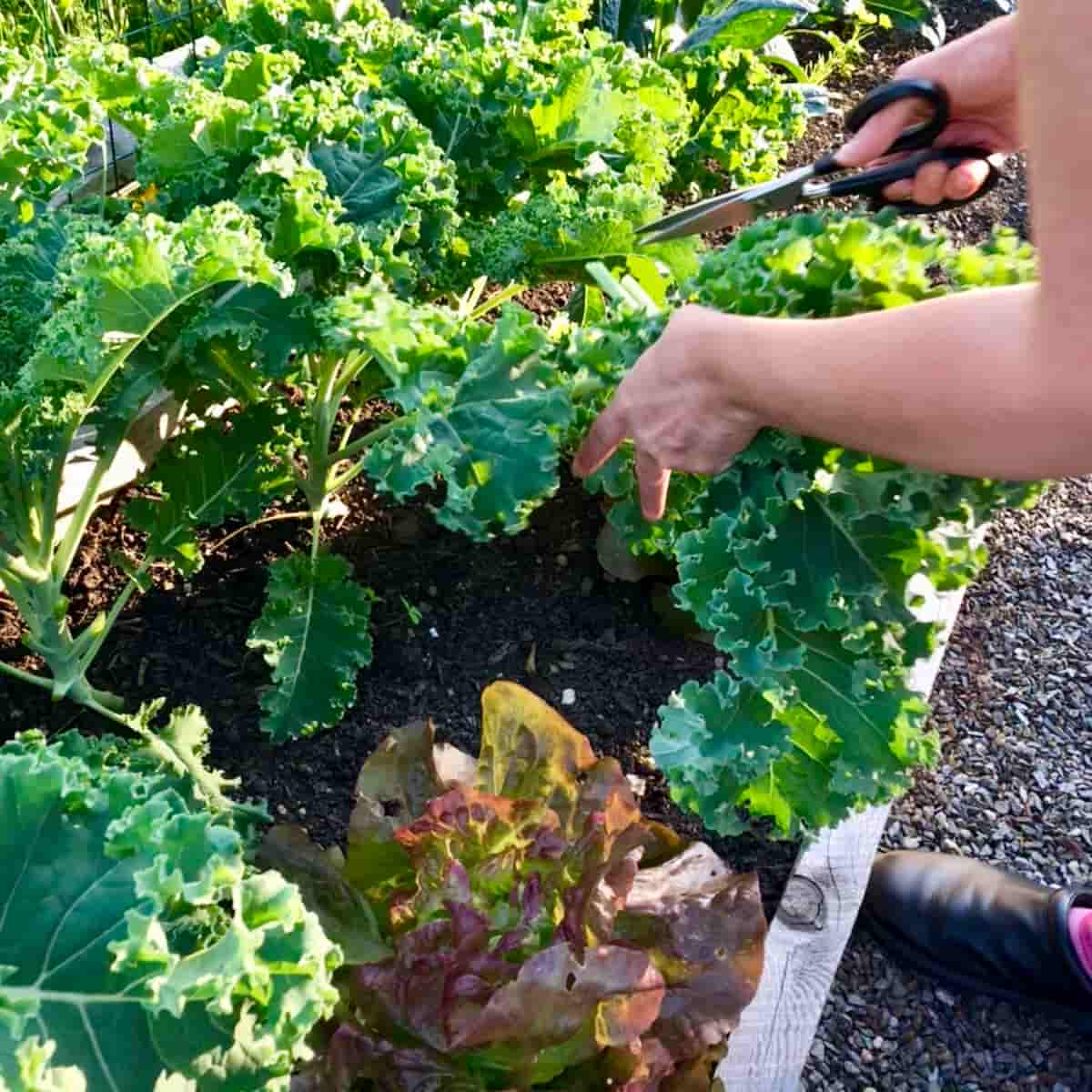Growing leafy greens on raised beds is a fantastic way to maximize your harvest and minimize the effort required. Raised beds offer several advantages over traditional gardens. They help improve drainage and prevent soil compaction while providing better control over soil quality and temperature.

How to Grow Leafy Greens on Raised Beds
The Best Soil Mix for Growing Leafy Greens on Raised Beds
- The ideal soil must be loose and well-draining yet still able to retain moisture. A good rule is to use a mixture of 50% topsoil and 50% organic matter, such as compost.
- Adding compost not only enriches the soil with nutrients but also helps improve its structure. Compost has beneficial microorganisms that promote healthy plant growth while breaking down organic matter into humus, improving soil water retention.
- Another important factor in choosing the best soil mix for growing leafy greens is ensuring a neutral pH level between 6-7.5. Soil acidity affects plant nutrient availability and can lead to stunted growth or yellowing leaves.
- To maintain optimal pH levels and provide essential nutrients like nitrogen, phosphorus, and potassium, consider adding amendments such as bone meal or fish emulsion fertilizer when preparing your soil mix. A high-quality soil mix with good drainage properties and regular fertilization will ensure robust growth of your leafy greens on raised beds throughout their life cycle.
Which Leafy Greens to Grow on Your Raised Bed?
Leafy greens like Lettuce, Spinach, Kale, Arugula, Swiss Chard, and Collard Greens are great choices for a successful raised bed garden. These varieties thrive in the nutrient-rich soil of a raised bed and have shallow root systems that make them easy to care for.
Best Height for Raised Garden Beds for Growing Leafy Greens
- For smaller leafy greens like Lettuce plants, Arugula, and Spinach, a 6-inch raised bed is perfectly fine. These leafy greens have shallow roots and do not require deep soil depths to thrive.
- However, if you plan on growing larger or deeper-rooted vegetables like tomatoes or carrots alongside your leafy greens, you may opt for a taller raised bed. A depth of at least 12 inches would be more suitable.
- Ultimately, the best height for your raised garden bed will depend on several factors, including which plants you’re growing and personal preferences regarding accessibility.
Raised Bed Garden Care and Plant Protection for Growing Leafy Greens
- Proper watering is crucial for growing leafy greens on raised beds. Overwatering or underwatering can lead to stunted growth or even death of your plants. It’s important to keep the soil moist.
- Weeding is another essential task in maintaining a healthy and thriving garden. Regularly pulling out weeds by hand or using a hoe will help keep them at bay.
- Fertilizing your leafy greens is also important, as they require a consistent supply of nutrients throughout their growth cycle. Organic fertilizers like compost or worm castings will provide the necessary nutrients without harmful chemicals that could damage the environment.
- Plant protection from pests and diseases should also be considered. Insects like aphids, whiteflies, and caterpillars are common pests that can damage your plants, while diseases like powdery mildew and downy mildew can infect them if left unchecked. Using natural methods such as neem oil spray or companion planting with marigolds can help deter pests while keeping an eye out for any signs of disease will allow you to take prompt action if needed.
In case you missed it: Frequently Asked Questions About Raised Bed Gardening

How to Build a Raised Bed for Leafy Greens
- Building a raised bed for leafy greens is an easy way to create a thriving garden. The main step in building your raised bed is selecting the right location. Select an area with at least six hours of sunlight daily and good drainage.
- You can use wood, cinder blocks, bricks, or recycled materials such as old pallets or tires. Ensure your material is non-toxic and will not leach harmful chemicals into your soil.
- Once you have selected your materials, it’s time to assemble your raised bed. Stack the materials on each other until you reach your desired height. Consider lining the inside with landscaping fabric or plastic sheeting to prevent rotting if using wood.
- After assembling your raised bed, fill it with a soil mix designed for growing vegetables high in organic matter.
Steps for Growing Leafy Greens on Raised Beds
- Select the leafy green you want to grow and plan accordingly. Then set up your raised bed in a sunny spot with good drainage. Fill it with nutrient-rich soil mixed with compost and organic matter.
- Leafy greens require consistent moisture levels in the soil, so be sure to water them regularly and deeply. Additionally, consider adding a nutrient-rich compost or fertilizer into the soil mix before planting.
- Another way to encourage fast growth in your leafy green plants is by providing adequate sunlight exposure. Ensure your raised bed receives at least 6 hours of direct sunlight daily. If necessary, consider using shade cloth or other methods for protecting delicate seedlings from harsh sun rays.
- Planting leafy greens is relatively easy. Before planting leafy greens, loosen the soil to a depth of at least 6 inches. Then, this will allow air and water to penetrate more efficiently, making growing roots easier.
- When planting your seeds or seedlings, ensure they are spaced appropriately so they have enough room to mature without overcrowding each other. Water frequently, but avoid over-watering as this can cause root rot or fungal diseases.
- When planting seeds, follow the instructions on the seed packet regarding depth and spacing. For example, lettuce seeds should be planted around ¼ inch deep and spaced about 4-6 inches apart in rows approximately 12 inches apart.
- Once your leafy greens have started growing, ensure they receive enough water to keep them hydrated but not too much to become waterlogged. You should gently water your plants every day or two if there is no rain.
- Protect your plants from pests such as slugs or snails by using natural deterrents like copper tape around the edges of your bed or diatomaceous earth sprinkled around the base of each plant.
- Regular pruning and harvesting can stimulate new growth in leafy green plants. Be sure to promptly remove any yellowing or damaged leaves, allowing the plant’s energy resources to focus on producing new healthy foliage instead.
In case you missed it: The Best Homemade Liquid Fertilizer for Raised Bed Plants

Conclusion
Leafy greens are easy to grow and maintain in raised beds, making them an ideal choice for beginners. Growing leafy greens on raised beds is a great method to ensure plants get the right water, nutrients, and sunlight.
- Ultimate Guide to Ossabaw Island Hog: Breeding, Raising, Diet, and Care
- Ultimate Guide to Juliana Pig: Raising Facts, Size, Diet, Care, and Lifespan
- Raising Lleyn Sheep: Disadvantages, Price, Uses, Characteristics, and Care
- Ultimate Guide to Meishan Pig: Breed Facts, Breeding, Raising, and Care
- Ultimate Guide to Teacup Pigs: Raising, Diet, Lifespan, Cost, and Care
- Guide to Raising Poll Dorset Sheep: Facts, Profile, Characteristics, Uses, and Care
- Ultimate Guide to Bighorn Sheep: Characteristics, Diet, Lifespan, Breeding, and Lifecycle
- Ultimate Guide to Raising Katahdin Sheep: Farming Facts, Breed Profile, Uses, and Care
- Ultimate Guide to Raising Oreo Cows: Belted Galloways Farming Facts, Profile, Uses, and Care